Figure 1.
Narciclasine improved survival and reduced the bacterial load in neonatal rats with sepsis. (a) Sepsis was induced in the rats (n = 6 per group) followed by administration of narciclasine (NC, 0.1, 1 and 3 mg/kg) after 1 hour and their survival was monitored for 30 hours. Data are presented as the survival percentages of rats. (b) The clinical signs were scored for 30 hours after sepsis induction. Data were expressed as mean ± SEM. (c–f) Sepsis was induced in the rats (n = 6 per group) followed by narciclasine administration (NC, 0.1, 1 and 3 mg/kg) after 1 hour. Blood, peritoneal fluid, livers and lungs were collected after 12 hours. Bacterial counts were estimated after 24 hours of incubation. Data were expressed as medians and compared using Kruskal-Wallis test. (a,b) ***P < 0.001, compared with sham/control group; #P < 0.05, ##P < 0.01, ###P < 0.001, compared with untreated sepsis group. (c–f) ###P < 0.001, compared with sham/control group; *P < 0.05 compared with untreated sepsis group.

